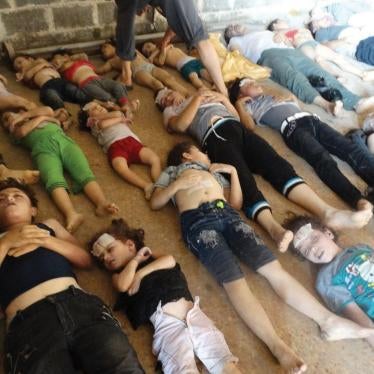(Tunis) – Governments at the “Friends of Syria” meeting in Tunis on February 24, 2012, should enlist the support of Russia and China to push Syria to stop its indiscriminate shelling of residential neighborhoods in the city of Homs, Human Rights Watch said today. They should also press Syria to allow delivery of humanitarian aid and permit safe passage for all civilians who wish to leave.
Since February 3, Syrian army shelling of Homs has killed at least 373 people, according to Syrian monitoring groups, and wounded hundreds of others, including women and children. Local residents who spoke to Human Rights Watch estimate that at least 20,000 residents remain in the Baba Amr neighborhood – the hardest hit area. Video footage from Homs reviewed by Human Rights Watch indicates that the army has used Russian-made 240mm mortar systems against Homs. These systems fire the world’s largest high explosive mortar bomb, designed to “demolish fortifications and fieldworks” according to a Russian arms merchandizing catalogue.
“The indiscriminate attacks on populated areas with heavy-duty weapons in Homs and other cities demonstrate the price of blocking an international consensus to end the horrific human rights violations in Syria,” said Joe Stork, deputy Middle East director at Human Rights Watch. “Russia and China have a particular responsibility to put pressure on Syria, given that they vetoed Security Council consensus, and Syria has so far shown itself impervious to condemnation by most other states of its actions.”
In the early afternoon of February 21, a Syrian activist in the Baba Amr neighborhood told Human Rights Watch that the army started shelling his neighborhood at 6:20 a.m. and that the shelling had so far that day killed 16 residents, including two women and two children:
The situation of the wounded is a disaster. We are treating them in makeshift clinics that lack everything. We are running out of basic medication, food, water. Everything. So many wounded are dying because they cannot get proper care.
Marie Colvin, one of two Western journalists killed in Baba Amr on February 22 by Syrian army shelling, had reported the previous day that she had witnessed 14 shells fall on the neighborhood in the span of 30 seconds and had watched a baby die of shrapnel wounds for lack of proper medical care. Another Western journalist who was in Baba Amr from February 15 to 17 told Human Rights Watch that “on a good day, a shell hit the neighborhood every 4 to 5 minutes while on a bad day, they heard 55 shells in 15 minutes.”
The situation in Homs has become so dire that the International Committee of the Red Cross (ICRC) called on February 21 for a daily two-hour truce to allow delivery of vital aid and to evacuate the wounded and the sick. A day later, according to news reports, Russia’s Foreign Ministry expressed concern about the “difficult humanitarian situation in Syria” and support for the efforts of the ICRC to establish a truce.“Russia’s leadership has shielded Bashar al-Assad as he has waged war on his own people,” Stork said. “If Russia is concerned about the plight of civilians as it claims, it should act urgently to broker an arrangement that allows safe passage of civilians, injured people, humanitarian aid, and above all an end to the indiscriminate shelling of Homs. Expressions of concern are a step forward, but Syrians need international action.”
A video posted to YouTube on February 16 by Homs residents documents the use of 240mm F-864 high explosive mortar bombs in the city by the Syrian army. A resident of Homs who said he knows the two men in the video confirmed to Human Rights Watch that the footage was filmed in the old part of Baba Amr, known as al-Hakura. This Russian-made munition shown in the video is the largest mortar bomb known to be in production and use. It weighs 130 kilograms and contains 31.93 kilograms of TNT as an explosive charge.
Fired by a mortar that is either towed or mounted on an armored vehicle, this weapon system is notable for its capability to conduct a “plunging attack,” in which the munition is fired at a high angle and comes down nearly perpendicular to penetrate a building or fortification. The authoritative “The Military Balance 2011,” published by the International Institute for Strategic Studies, says Syria possesses ten 240mm mortar systems.
Human Rights Watch and 143 international and Arab nongovernmental organizations had earlier urged the “Friends of Syria” to outline a strategy to end the human rights violations in Syria and secure accountability for crimes against humanity.





